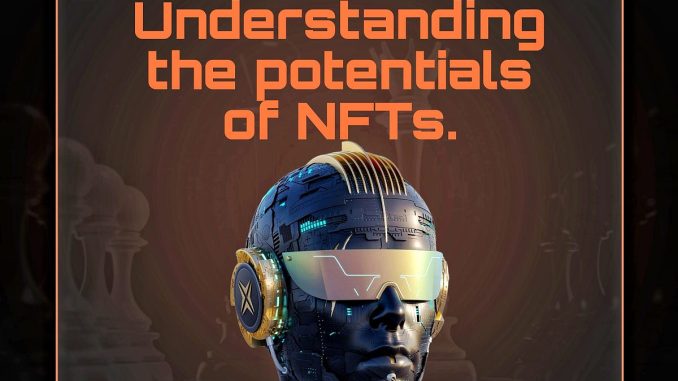
In recent times, Non-Fungible Tokens (NFTs) have become the talk of the town, capturing the imagination of both tech aficionados and those still navigating the world of the digital realm. This article seeks to delve deep into the world of NFTs, shedding light on the legal implications and practical considerations that accompany this burgeoning digital asset landscape.
A quick sweep into what NFT is.
Non-fungible tokens are distinct digital assets that demonstrate ownership or proof of validity for a certain object or content. Unlike cryptocurrencies like Bitcoin or Ethereum, NFTs are indivisible and cannot be swapped one-for-one. Each NFT is unique, with blockchain technology to assure transparency and traceability.
Smart Contracts: The Backbone of NFTs
At the heart of NFTs lie smart contracts – self-executing agreements coded into blockchain networks. These contracts define the terms of ownership, transferability, and even automate royalty payments to creators each time the NFT changes hands. Ethereum, a popular blockchain for NFTs, utilizes smart contracts to establish and enforce these rules.
Now that we understand briefly what NFT is all about and how it is materialized, let us walk further into the legal landscape:
While owning an NFT signifies ownership of the token, it does not confer ownership of the underlying intellectual property. Artists retain their copyright, and unauthorized use or reproduction may still infringe upon these rights. It is imperative for both creators and buyers to be cognizant of these distinctions to avoid legal pitfalls.
Before jumping into the NFT market, it is critical to understand the terms and conditions established by the platform hosting the NFT. Each platform sets its own restrictions, transaction fees, and procedures. Some platforms may allow creators to maintain certain rights, while others may provide more to the buyer. Understanding these contractual agreements is critical to ensure that the transaction runs smoothly and lawfully.
One of the innovative aspects of NFTs is the incorporation of resale royalties into smart contracts. Creators can receive a percentage of the resale value each time their NFT changes hands, ensuring an ongoing revenue stream. This feature has significant implications for artists and has the potential to reshape traditional art markets.
That being said, let us launch into practical considerations:
NFTs, particularly those built on blockchain networks like Ethereum, often rely on a Proof-of-Work consensus mechanism, criticized for its environmental impact due to high energy consumption. The industry is witnessing a shift towards eco-friendly alternatives, like Proof-of-Stake, to address these concerns.
The NFT market is dynamic, with prices fluctuating rapidly due to demand and popularity. Investors and collectors should be mindful of the inherent volatility, knowing that the value of an NFT might fluctuate fast, resulting in significant financial gains or losses.
As the NFT market experiences exponential growth, the risk of scams and fraudulent activities also increases. Verifying the authenticity of an NFT, conducting due diligence on the creator, and utilizing reputable platforms are essential steps to mitigate the risk of falling victim to fraud.
Immersing oneself in the realm of NFTs necessitates a deep awareness of both the technological and legal aspects. The decentralized structure of blockchain technology promotes openness, but it is critical to understand the legal subtleties, market risks, and potential dangers. Whether you’re a seasoned tech enthusiast or a curious newbie, diving into NFTs requires a mix of excitement and caution in this exciting digital frontier.
As we conclude our journey through the labyrinth of NFTs, it’s evident that we’ve arrived at a crossroads of innovation and uncertainty. NFTs are more than just digital collectibles; they represent a paradigm change, altering our perceptions of ownership, creativity, and the essence of value.
In the legal world, there is a tango between smart contracts and traditional intellectual property rights. NFTs have created a new canvas in which artists retain ownership, royalties flow easily, and every transaction is recorded in the immutable ledger of blockchain. It’s a legal waltz in which comprehending the fine print isn’t just advisable, but critical.
But let’s not forget about practicality. The NFT market is a rollercoaster, so buckle up. Your digital masterpiece’s worth could explode or plummet dramatically. It’s an exciting bet with stakes as dynamic as the digital world itself.
Oh, the environmental drama! NFTs have a front-row seat in the blockchain energy debate. While Ethereum, the reigning king of NFTs, may have a high carbon footprint, more environmentally friendly options are emerging. It’s as if Mother Earth nudged us and said, “Go green or go home!”
Are there any scams or fraud going on in the NFT universe? Unfortunately, we didn’t ask for this reality program. Fear not, fellow digital adventurers! Verify, research, and tread carefully. It’s the wild west out there, but with a little street smarts, you can get through the maze without losing your virtual shirt.
In essence, NFTs are more than just digital bling; they’re a testament to the ever-evolving relationship between technology and creativity. Whether you’re a tech whiz or someone still figuring out the difference between a JPEG and a GIF, the NFT frontier invites you to explore, learn, and maybe even create a digital legacy.
So, here’s to the NFT pioneers, the artists breaking new ground, and the collectors riding the digital wave. It’s a brave new world out here, and the adventure has only just begun. Buckle up, because in the realm of NFTs, the only constant is change, and the possibilities are as boundless as the digital horizon. Cheers to the pixels, the smart contracts, and the wild ride ahead!
Don’t forget to follow us, like and share.










